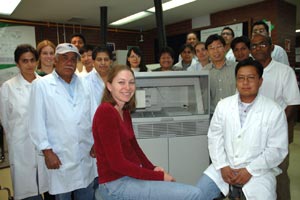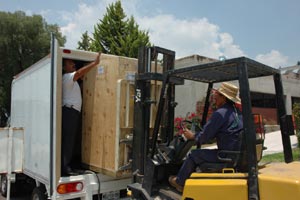CIMMYT E-News, vol 4 no. 8, August 2007
Faster, cheaper, more efficient: gift from DuPont helps CIMMYT scientists look for genes in wheat and maize—and gives breeders an affordable tool to help select the best.
 A quiet revolution is taking place in CIMMYT’s biotechnology labs. The team has just received a new generation of genotyping machines. These semi-automated work-horses will make it much easier to determine whether breeding lines contain specific useful genes. It is hoped that this will help maize and wheat breeders—through a process known as marker-assisted selection (MAS)—to make breeding more effective and get crop varieties with valuable traits to poor farmers more quickly.
A quiet revolution is taking place in CIMMYT’s biotechnology labs. The team has just received a new generation of genotyping machines. These semi-automated work-horses will make it much easier to determine whether breeding lines contain specific useful genes. It is hoped that this will help maize and wheat breeders—through a process known as marker-assisted selection (MAS)—to make breeding more effective and get crop varieties with valuable traits to poor farmers more quickly.
Traditionally, the only way to find out whether the offspring from a particular cross have inherited useful characteristics, such as drought tolerance, disease resistance, or grain quality, has been to grow them in the field and evaluate the adult plants. MAS can speed up the breeding process, since it makes it possible to track the presence of desired genes in every generation. This does not bypass the need for field evaluation, but can greatly improve the efficiency of the process. “Field screening takes time, space, and resources, and our capacity is limited,” explains CIMMYT maize breeder Gary Atlin, “but with MAS we could use resources more effectively, zeroing in on the best lines to test in the field and filtering out those that haven’t inherited the characteristics we need.”
When researchers want to find out whether a particular line of wheat or maize has the useful version of a gene (for example, disease resistance rather than disease susceptibility), they use nearby, identifiable sections of DNA known as markers, labeled with a fluorescent dye. Different versions of markers and genes are called alleles. DNA that is close together on the chromosome tends to stay together over generations, so a specific allele of a marker will be routinely inherited alongside the desired allele of a nearby gene. Using the new capillary electrophoresis genotyping machines, the sample is forced along a narrow capillary tube under the influence of an electric current. A laser at the end of the tube detects the different alleles of the fluorescent markers, indicating to the scientist whether the sample contains the allele they want.
 The two ABI 3700 machines have been generously donated to CIMMYT by DuPont through its Pioneer Hi-Bred seed business, reflecting a fruitful collaborative relationship of more than a decade’s standing. Until now, CIMMYT has run most of its marker-assisted selection work on manual, gel-based electrophoresis apparatuses. In addition, analyses of genetic relationships between different wheat or maize lines have been run on older ABI genotyping machines, including two based on the previous, much slower generation of gel-based machines. The new machines can handle many more samples—96 each at a time—but it’s the savings in hands-on time that makes the real difference. “There’s no comparison,” says Marilyn Warburton, Head of CIMMYT’s Applied Biotechnology Center. “It will take us ten minutes to load one of these new machines, whereas it takes about four hours to make and load a manual electrophoresis gel.”
The two ABI 3700 machines have been generously donated to CIMMYT by DuPont through its Pioneer Hi-Bred seed business, reflecting a fruitful collaborative relationship of more than a decade’s standing. Until now, CIMMYT has run most of its marker-assisted selection work on manual, gel-based electrophoresis apparatuses. In addition, analyses of genetic relationships between different wheat or maize lines have been run on older ABI genotyping machines, including two based on the previous, much slower generation of gel-based machines. The new machines can handle many more samples—96 each at a time—but it’s the savings in hands-on time that makes the real difference. “There’s no comparison,” says Marilyn Warburton, Head of CIMMYT’s Applied Biotechnology Center. “It will take us ten minutes to load one of these new machines, whereas it takes about four hours to make and load a manual electrophoresis gel.”
As well as being much quicker and less labor-intensive, capillary electrophoresis makes it possible to test for more than one marker and run more than one sample at once in each tube. By using different colors of fluorescent dye for each sample, markers for each can be distinguished, like teams of runners wearing different-colored jerseys. For maximum efficiency, scientists can also set up groups of samples to run at slightly different times, like runners set off in a staggered start. CIMMYT will even be able to develop a new type of marker, known as SNPs, which allow numerous traits to be tested simultaneously, providing more information per sample.
All of this means that the new machines have a much higher throughput capacity, and can process many more samples for the same labor input, drastically reducing the per-sample cost—currently the major constraint on use of MAS. “If MAS were significantly cheaper, I would certainly use it in maize breeding,” says Atlin. “Effectively, it lets you quickly transfer the genes you want into improved varieties. If you’re doing a backcross between a donor with a desired trait and an improved parent with good agronomic performance, you’re trying to select for one characteristic from the donor, but against all its other genes. With a number of markers, MAS makes it possible to determine exactly which progeny combine the desired gene from the donor with the good genes from the other parent. You can get results in two generations, compared to four or five normally.”
The challenge for MAS is finding genes with substantial effects, especially for complex traits such as drought tolerance in maize. Atlin believes such genes are still to be found. “In the past, donors with a single useful gene or trait but otherwise poor agronomic qualities were very difficult to use in breeding, as they introduced so much bad material. We can get rid of that useless material through MAS. That opens up the field to look for useful genes in a wider range of parents. And genotyping technology is getting cheaper and better at finding genes all the time.”
In wheat, the hunt for useful markers at CIMMYT is more advanced. “We’re working with new markers to select for nematode resistance, leaf and stem rust resistance, boron tolerance, Fusarium resistance, and grain quality,” says Susanne Dreisigacker, CIMMYT wheat molecular biologist. “Our current work is all gel-based, which means running tests sample by sample and marker by marker. Being able to run many samples at the same time will make a huge difference.”
For more information: Marilyn Warburton, molecular geneticist (m.warburton@cgiar.org)
 Poverty reduction, livelihoods and jobs
Poverty reduction, livelihoods and jobs 
